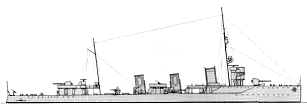
NAVYPEDIA
 Support the project with paypal
Support the project with paypal
Ships
| Name | No | Yard No | Builder | Laid down | Launched | Comp | Fate |
|---|---|---|---|---|---|---|---|
| Melilla (ex-Falco, ex-Viscol) | Pattison, Naples, Italy | 3.1914 | 26.7.1916 | 2.1917 // 10.1937 | stricken 11.1950 | ||
| Ceuta (ex-Aquila, ex-Vifor) | Pattison, Naples, Italy | 8.1916 | 16.8.1919 | 1.1920 // 10.1937 | stricken 4.1948 |
Technical data
| Displacement standard, t | 1410 |
|---|---|
| Displacement full, t | 1820 |
| Length, m | 94.3 wl 94.7 oa |
| Breadth, m | 9.47 |
| Draught, m | 3.35 normal 3.60 max |
| No of shafts | 2 |
| Machinery | 2 Tosi steam turbines, 5 Thornycroft boilers |
| Power, h. p. | 40000 |
| Max speed, kts | 34 |
| Fuel, t | oil 270 |
| Endurance, nm(kts) | 1700(15) |
| Armament | 2 x 2 - 120/45 Schneider-Canet-Armstrong 1918-19, 2 x 1 - 76/40 Ansaldo 1917, 4 x 1 - 6.5/80, 2 x 2 - 450 TT, 50 mines, 1 DCR |
| Complement | 160 |
Standard scale images

Melilla 1938
Project history
Former Italian destroyers, ordered in Italy by Romania in number of four in 1913, after joining of Italy into the First World War they were requisitioned by Italian Government 5.6.1915 and completed for Italian Navy as "esploratori" ("scouts"). In 1920 two ships were redeemed by Romania, two (Aquila, ex-Vifor) and (Falco, ex-Viscol) remained Italian. In September, 1937 they were bought by Government of Spanish Nationalists and transferred to Spanish crews 10.10.1937. For concealment of fact of purchase both ship up to termination of Civil war stood out for Nationalists destroyer Velasco, in this connection till 1939 they carried fictitious double names Velasco-Melilla and Velasco-Ceuta and for similarity with Velasco false fourth funnel was installed. They were officially stricken by Italian Navy only 6.1.1939. By the moment of acquisition by Nationalists both ships were in bad technical condition and had worn out machinery in which constantly there were accidents. They differed also by small endurance.
Modernizations
1938, both: + 4 x 1 - 20/65 C/30
Naval service
After 1939 both served mainly as TSs.
 HOME
HOME FIGHTING SHIPS OF THE WORLD
FIGHTING SHIPS OF THE WORLD SPAIN
SPAIN TORPEDO SHIPS
TORPEDO SHIPS MELILLA destroyers (1917-1920/1937)
MELILLA destroyers (1917-1920/1937)
